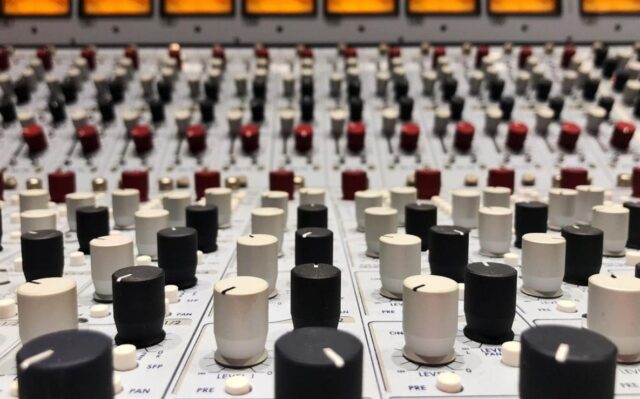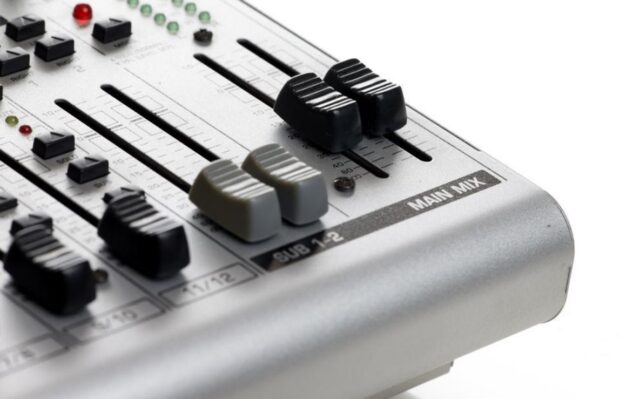
High-quality mixing and mastering are the key to professional sounding. These two terms tend to be confused since the line between them is very thin. Well, let’s look at them closer.
Audio mixing is a process of editing various elements of a composition, which is carried out through equalization, compression, spatial effects and other types of processing. The aim of mixing is to improve the sound quality of the instruments in the context of a particular track. After mixing, the track is prepared for the final stage of production – mastering.
Mixing helps you to achieve the correct balance and dynamics of the various components of the composition. It also allows you to prepare a track for mastering.
Mastering is a set of actions, passing through which, the recording undergoes final processing and reaches the highest level of quality and fullness of sound. Without mastering, the music lacks completeness: it becomes noticeable that the track is not completely finished.
Music mixing and mastering are certainly better to be done by sound experts, however, some artists do it by themselves. There are certain steps they need to follow processing qualitative sound edit.
For fans of good music, it is important that their favorite artist or band produces quality music, and that those tunes have extra quality no matter what device will be heard.
Even if you are a big fan of music and you want to create your own unique tunes and compositions, you can apply these two techniques of mixing and mastering yourself. All you need is music software that will help you make changes to your music and bring it to the point where you think it will sound perfect. If you have a good hearing for music and know how to use the software, it is a good idea to try this field. There is nothing to lose, all you can do is improve the sound of your composition.
Mixing Steps
This is the first stage of technical refinement of a track, immediately after the arrangement is written and the samples are placed on the project timeline. In a superficial sense, the task of this stage is to ensure that all the instruments of the track are simply audible and not masked one after another. Audio mixing is a creative process. For this purpose, the settings for volume, panning, as well as equalization, compression, reverb and echo are used.
There are few tips for successful mixing:
- Adjust instrument volume and panorama. The volume and pan parameters are very important. Setting them up correctly creates a sense of space, helps to achieve a cleaner sound and gives an idea of how the final result will sound. Try to imagine how these instruments would sound in a room if a group of musicians were playing them: Some elements would also sound more distant, while others more close. This is called panning. It’s simple to recreate this effect – the quieter the volume of the track, the further away from the listener the sound will be perceived. The headroom is also important. This value indicates the number of decibels up to the maximum volume level that can be achieved without clipping. Remember – the volume meters should not light up red.
- Equalizer. Equalizer is a plugin that is used to decrease or increase the volume of individual frequencies (low, medium and high). It allows you to cut out unpleasant frequencies and focus on more euphonious parts of the sound. The goal of EQ is to balance and improve the sound of instruments in context, rather than individually.
- Compression. It makes quiet moments louder and loud ones quieter. Thanks to this processing, the sound of the instrument becomes more stable and balanced in volume.
- Reverb. Reverb is a type of processing that conveys the effect of being in a specific room. In the real world, it accompanies most of the sounds we hear in everyday life. During this mixing stage, you have the opportunity to add this effect to any type of signal in any amount.
- Echo. The essence of this effect is that gradually fading multiple repetitions of the same sound are added to the signal. Now your track is ready for the final stage – mastering.
Mastering Steps
The mastering process involves the following points: combining the overall sound of the recording, maintaining the consistency of the tracks on the album and preparing for distribution. The point of this action is to finalize the complete sound of the melody before it is released. The track has to be perfected to that level so that it can be played on any speaker, whether it is broadcast on radio, television or people play it over and over on their music playlist. There are three main stages.
- Installation. First of all, phonograms are opened in the audio editor and then arranged in the desired sequence at certain intervals. If necessary, in the beginnings and endings of phonograms, smooth deductions and decays of sound are made. This step also removes recording defects (clicks, crackles, noises, etc.) that were not previously detected.
- The final processing of the sound. Dynamic processing, timbre correction, volume leveling of phonograms are carried out. At this stage, depending on the tasks set, the recording can become more transparent, soft, dynamic, and acquire a richer sound. With good mastering, the result of the work can overwhelm with its sound.
- Production. The final versions of phonograms are transferred to certain carriers for replication. It does not matter if you are a professional who has been doing this for many years, it is important that the final product sounds phenomenal and intrigues music lovers. With this final step you enable the melody to be played on all divisions or music platforms and its sound to be of excellent quality.
The difference between mixing and mastering
- Mixing aims to reshape the sounds of each instrument individually, and mastering improves their overall joint sound performance
- The mix balances certain elements of the song, and mastering takes that stereo sound and creates a completely new one that will be of good quality and can be played on all systems and formats as a final melody.
- If you mix the song you have already done most of the work, but without mastering the same piece can not be released for distribution. These two components simply have to be upgraded to produce a complete soundtrack.
- While the mixing has to do most of the work, mastering aims to give character to the song that will make it good to listen to and will satisfy the market, ie will delight the listeners of that genre.
Conclusion

Music mixing and mastering is a must for converting a simple set of sounds into a single picture, for making them a dense and legible mix. Nowadays, some musicians suggest that in the case of excellent sound quality of the recording, there is no need for mix and mastering service. This statement is true, but only if you do not intend to enter the professional music market with your recordings. But if you are thinking of seeing your songs see the light of day and be heard by the general public, after you finish the work with the production of the song itself, there is a part where your track will be processed to get that professional sound. If you need such services to feel free to check out majormixing.com. They will make your tune sound magical and win over true music lovers. In their range, they offer services especially for mixing the song and especially for mastering it. But also offer to choose an option where both services will be included. It is up to you to choose what exactly you need. And leave the rest to them because they are complete professionals in what they do and they will certainly not disappoint you. Their ten years of experience speak volumes about their professional work. If you are aiming for the commercial success of your work, you should consider these processes.











